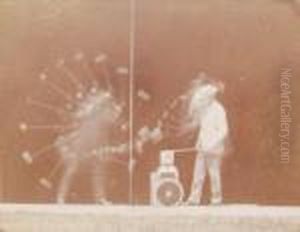Etienne Jules Marey Paintings
Étienne-Jules Marey was a French scientist, physiologist, and pioneer in the field of motion photography, born on March 5, 1830, in Beaune, Burgundy, France. He is best known for his work on human and animal locomotion, which played a crucial role in the development of early cinema and photographic technology.
Marey initially studied medicine in Paris and became a professor of natural history at the Collège de France in 1867. His early work revolved around blood circulation, and he invented scientific instruments, such as the sphygmograph, to measure the pulse. However, his interests soon shifted to the study of motion, influenced by the work of English photographer Eadweard Muybridge.
In the 1880s, Marey developed a technique called chronophotography, which allowed him to capture several phases of movement in a single photograph. To achieve this, he invented the chronophotographic gun, a camera shaped like a rifle that could take 12 consecutive frames per second. With this and other devices he created, Marey could analyze the motion of various subjects, including humans, birds, horses, and other animals.
His research resulted in a series of striking images that depicted the rhythm and pattern of movement, and his methods were considered revolutionary at the time. Marey's work directly influenced the birth of motion pictures. His investigations into how images could represent movement led to the development of cinematography. Alongside Muybridge, he is credited with laying the groundwork for the motion picture industry through his exploration of how to capture and display motion.
Marey's influence extended beyond photography and film; his work also impacted art, particularly the Futurists and other avant-garde movements that aimed to depict movement and speed. His chronophotographs were not only scientific studies but also had an aesthetic quality that made them compelling to a wider audience.
Étienne-Jules Marey passed away on May 15, 1904, in Paris. His legacy is preserved in the scientific community and the art world for his innovative approach to understanding and depicting motion. The insight gained from his chronophotography has continued to contribute to various fields, including biomechanics and animation, long after his death.
